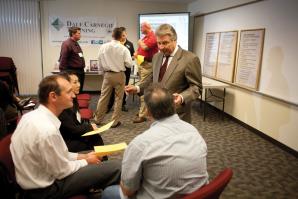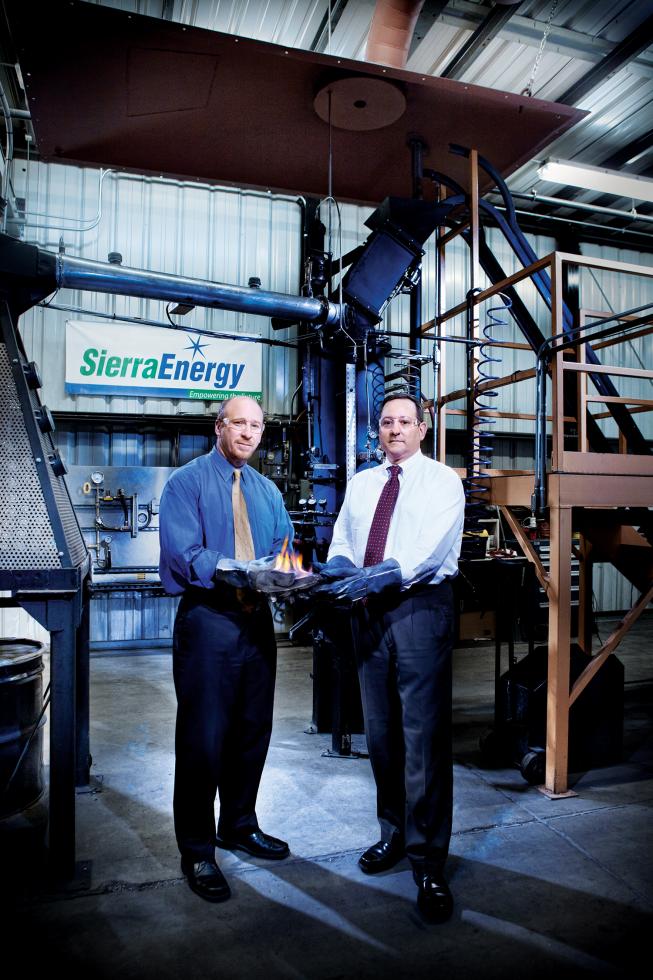Since founding Sierra Energy Corp. in 2004, Mike Hart has led the charge to make it a force in the world of renewable energy. This year, with a working gasification system to demonstrate for new investors, Hart is stepping aside as CEO.
“I am not the right person to take the company to that stage,” says Hart, who retains the title of president. Instead, he has brought on Douglas Miller as chief executive.
Miller spent the past two years at Rentech Inc. as head of its renewable energy business. Rentech is the kind of big player that can use Sierra Energy’s gasified waste stream and turn it into clean fuels. His resumé also includes experience as a vice president of Unocal Corp.
“In many cases where we have spent years establishing a fragile relationship with a company, he is able to step in several layers higher,” Hart says.
Hart is voluntarily making a move often forced upon some startup CEOs by their boards or investors. It’s a recognition, sometimes reluctant, that it takes a different set of skills to start a company than to take it through the various stages of fundraising, production and profitability.
Hart has a clear view of his own limitations and knows it’s his company, not his ego, that’s on the line. Hart doesn’t draw a salary from Sierra Energy. He’s counting instead on his ownership share for payback down the road.
“I am looking for what will drive up my stock price the soonest,” he says.
Then there’s another kind of founder, too wrapped up in the startup to keep perspective.
“Oftentimes they don’t even realize their own shortcomings, and they become the biggest stumbling block to attracting someone into the organization,” says executive recruiter Dave Sanders, managing partner with WorldBridge Partners in Roseville. ”Getting them out of that role is a real challenge, and they go kicking and screaming.”
In the standard corporate structure, the CEO serves at the pleasure of the board of directors, which often includes major investors. Keeping the founder on board is one of the highest priorities, says venture capitalist Scott Lenet, managing director at DFJ Frontier, but not at the cost of the portfolio company’s success. His firm conducts a CEO review each year at each of its portfolio companies.
A company might need new leadership when it goes from testing to production, when it needs a larger round of funding or when the founding CEO has simply had enough.
“There’s no magic answer to knowing when it’s time,” Lenet says. “For us, we base it on what are we hearing from this person and, No. 2, what are we seeing. Every single company is different. You have to look at each business, and figure out if it is maximizing its potential.”
Good communication among the CEO, the board and the investors makes it easier to bring in a relief pitcher with minimal uproar, he adds. Part of due diligence for any good venture capitalist is to find out whether succession will be an issue. DFJ Frontier makes it clear at the start that it might insist on a change at some point, Lenet says.
Jacob Jorgensen has seen the switch played out from three perspectives. Currently a general partner with Velocity Venture Capital LLC in Folsom, Jorgensen has been a founder who gave up the CEO slot and a CEO who replaced a founder.
“It’s basically a fine art, both in being a good startup CEO and even in determining whether a candidate could be a good startup CEO,” he says. Being a founder means investing a lot of yourself in a company.
“You have your baby that you have incubated for years: coming up with an idea, getting a patent, thinking of building a prototype,” he says. “By the time you have a company with one or more other people, you get pretty set on the course you think the company should be [on].”
Entrusting all that to somebody else can be one of the biggest challenges in the life of a startup.
“Many companies fail because that transition is not made or not made successfully,” Jorgensen says.
Like Hart, Jorgensen freely admits his limits.
“In my case, I was always a technical founder, and I always knew my strength was in technology, not sales or marketing,” he says. “I was eager to take advantage of someone else’s leadership. In some ways I didn’t have to go through the internal turmoil.”
Coming in as a relief CEO has its own set of hurdles. A CEO needs freedom to operate, but the founder may still have a controlling interest on the board, Jorgensen says.
It might be painful to decide that a founder doesn’t have what it takes to stay at the helm. But answering that question only leads to others: What set of skills does the company need instead, and where can it be found?
“It will vary depending on what stage the company is in,” Sanders says.
Taking a company to its first $10 million in revenue is a different job than growing a $10 million company into a $50 million organization. If the company is still raising capital, that’s a different job yet again.
“But it’s fundamentally easier to attract someone into a company if the company is close to breaking even and they already have raised a decent tranche of capital,” Sanders says. “They can focus more on building the company.”
The new CEO’s skills have to fill in the blanks, of course. If the founder was not adept at raising funds or managing people, the new CEO must have those strengths. Equally important is where those skills have been on display.
“Oftentimes they don’t even realize their own shortcomings, and they become the biggest stumbling block to attracting someone into the organization.”
Dave Sanders, executive recruiter and managing partner, WorldBridge Partners
A good candidate has shown an ability to grow a company beyond the point where the founder has brought it, Sanders says.
Many times a board or investor scouts larger companies for executives to pluck. Success there doesn’t always translate to the new setting.
“One of the lessons I’ve learned is that being an excellent CEO at a midstage or in a large corporate environment does not necessarily arm you with the skills to be a successful startup CEO,” Jorgensen says. A startup typically has scarce resources, little administrative support and few colleagues to brainstorm ideas. People who perform well in a large corporate setting can flounder in the unstructured environment of a startup.
For the best CEO candidates, it’s really a reverse job hunt.
“When you have a very experienced executive, obviously he has many options of where he can go,” Hart says. “It literally is a matter of bringing the resumé of your business to him.”
For Sierra Energy, it took some selling to get Miller on board. It’s a small company and entirely self-funded as a subsidiary of the Sierra Railroad Co., which runs tourist excursion trains. Having a working universal gasifier was a major element.
“The key to it was, he sees the potential. This could very quickly become a multibillion-dollar company,” Hart says. “It’s actually an exciting time because the technology is ripe. We could not have impressed someone with this level of experience a year ago.”
It’s expensive to add that kind of talent, but if the company takes off as Hart expects, it will justify the cost. Paying for Miller’s existing experience is a better deal than what it would cost the company to make the same gains without it, in essence.
Hart and his board knew Miller from the industry in which they work. Other companies go straight to the headhunters. Startups with venture backing often tap into the networks of the venture partners. Just as there are serial entrepreneurs to start businesses, there are serial CEOs to come in when a startup reaches a critical point. A large venture capital firm may have a stable of executives who can move from one portfolio company to another if needed.
“We are constantly interviewing candidates even if we don’t have an open position, just so we understand who is out there, what people are available and what their strengths are,” Jorgensen says. That way, they get to know candidates over weeks and months instead of having to size them up on short notice.
“What you don’t want to do is limit yourself to your local network,” Lenet says. “You want to get the best person you can in the world, and set your boundaries that far.”
Lenet has taught business classes at UC Davis, and as an exercise has had his students fill an advisory board for a fictitious company. Inevitably, they pick professors on campus because those are the experts that they already know in specific fields.
“It’s almost like you got your sister to buy your product,” Lenet says.
Companies can fall into the same trap if they limit themselves to what is convenient socially or geographically.
Whatever the skill set, a company is more likely to find it in the Bay Area than around Sacramento, Sanders says. The startup culture that radiates from Silicon Valley cuts both ways, though. It also offers more opportunities for relief CEOs without having to relocate to Sacramento.
Even so, it’s often easier to entice an executive out of the Bay Area than to lure someone to California from out of state.
“We look pretty inexpensive compared to the Bay Area or Southern California,” Sanders says. Someone from the Midwest might not see as much of a bargain in moving to Sacramento, especially for the already risky proposition of leading a startup.
For the new CEO to succeed, both she and the rest of the company need to agree on what defines success. At Sierra Energy, Hart, Miller and the board have put numbers on it. Miller has specific goals to hit by 100 days, six months and the first anniversary of becoming CEO.
“One of the things I frequently talk about with startups: They can easily become distracted,” Hart says. The CEO comes in aiming to address one problem, then the board tosses another problem in his lap, and the founder wants to see a third goal met.
“A set of written goals and objectives, and both sides agreeing to stick to it, avoids distraction,” Hart says.
Bringing in a new CEO, like any hiring decision, is no guarantee of success. If it doesn’t work out or if it didn’t work out in a previous gig, that’s not a career-ender.
“I have to say, I’ve had my own string of failures and have learned from them,” Jorgensen says. “So if there is a CEO who has had a failure, we won’t necessarily reject that guy.”
Recommended For You

Training Day
The Capital Region's best bets for leadership development
Small-company advancement is on the rise, and more local businesses are seeking innovative leadership training that can help catapult their companies into a source of industrial growth.

Mind Games
Tech darling Mark Otero hit it big, then almost hit restart
Bright orange walls and ergonomic chairs. A black conference table flanked by a half-dozen scruffy-chic men (zip-front sweaters, double-pierced ears, turn-of-the-millennium tattoos) and three times as many digital devices (nobody brought just one).



